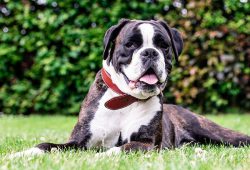The Boxer is a medium-sized, short-haired breed of dog, developed in [wiki base=”EN”]Germany[/wiki]. The coat is smooth and tight-fitting; colours are fawn or brindled, with or without white markings, and white. Boxers are brachycephalic (they have broad, short skulls), have a square muzzle, mandibular [wiki title=”Prognathism” base=”EN”]prognathism[/wiki] (an underbite), very strong jaws, and a powerful bite ideal for hanging on to large prey. The Boxer was bred from the Old English Bulldog and the now extinct Bullenbeisser which became extinct by crossbreeding rather than by a decadence of the breed. The purpose of the crossbreeding was the wish to eliminate the excessive white color of the breed, and the necessity of producing thousands of dogs for one of the most popular breeds in the world. The Boxer is part of the Molosser group. This group is a category of solidly built, large dog breeds that all descend from the same common ancestor, the large shepherd dog known as a Molossus. The Boxer is a member of the Working Group.
Appearance
The head is the most distinctive feature of the Boxer. The breed standard dictates that it must be in perfect proportion to the body and above all it must never be too light. The greatest value is to be placed on the muzzle being of correct form and in absolute proportion to the skull. The length of the muzzle to the whole of the head should be a ratio of 1:3. Folds are always present from the root of the nose running downwards on both sides of the muzzle, and the tip of the nose should lie somewhat higher than the root of the muzzle. In addition a Boxer should be slightly prognathous, i.e., the lower jaw should protrude beyond the upper jaw and bend slightly upwards in what is commonly called an underbite or “undershot bite”.
Temperament
Boxers are a bright, energetic and playful breed and tend to be very good with children. They are patient and spirited with children but also protective, making them a popular choice for families. They are active, strong dogs and require adequate exercise to prevent boredom-associated behaviors such as chewing, digging, or licking. Boxers have earned a slight reputation of being “headstrong,” which can be related to inappropriate obedience training. Owing to their intelligence and working breed characteristics, training based on corrections often has limited usefulness. Boxers, like other animals, typically respond better to positive reinforcement techniques such as [wiki title=”Clicker_training” base=”EN”]clicker training[/wiki], an approach based on operant conditioning and behaviorism, which offers the dog an opportunity to think independently and to problem-solve.
Health
Leading health issues to which Boxers are prone include cancers, heart conditions such as [wiki title=”Aortic_stenosis” base=”EN”]aortic stenosis[/wiki] and arrhythmogenic right ventricular cardiomyopathy (the so-called “[wiki title=”Boxer_cardiomyopathy” base=”EN”]Boxer cardiomyopathy[/wiki]”), [wiki title=”Hypothyroidism” base=”EN”]hypothyroidism[/wiki], [wiki title=”Hip_dysplasia_(canine)” base=”EN”]hip dysplasia[/wiki], and [wiki title=”Canine_degenerative_myelopathy” base=”EN”]degenerative myelopathy[/wiki] and epilepsy; other conditions that may be seen are [wiki title=”Gastric_dilatation_volvulus” base=”EN”]gastric dilatation volvulus[/wiki] (also known as bloat), intestinal problems, and allergies (although these may be more related to diet than breed). [wiki base=”EN”]Entropion[/wiki], a malformation of the eyelid requiring surgical correction, is occasionally seen, and some lines have a tendency toward spondylosis deformans, a fusing of the spine, or [wiki title=”Dystocia” base=”EN”]dystocia[/wiki]. Other conditions that are less common but occur more often in Boxers than other breeds are hystiocytic [wiki title=”Ulcerative_colitis” base=”EN”]ulcerative colitis[/wiki] (sometimes called Boxer colitis), an invasive E. coli infection, and [wiki title=”Corneal_ulcers_in_animals” base=”EN”]indolent corneal ulcers[/wiki], often called Boxer eye ulcers.
Nutrition
Boxer are very energetic even at old ages. They need plenty of exercise which means their diet should be high in quality calories. The main source of these calories should be lean animal protein, which include lean chicken, turkey, lamb and fish.
Uses
Boxers are friendly, lively companions that are popular as family dogs. Their suspicion of strangers, alertness, agility, and strength make them formidable guard dogs. As puppies, Boxers demonstrate a fascinating combination of mood-mirroring expressions, energetic curiosity, flexible attention spans and charming characteristics. They sometimes appear at dog agility or dog obedience trials and flyball events.
Boxer (dog). (2017, June 15). In Wikipedia, The Free Encyclopedia. Retrieved from https://en.wikipedia.org/w/index.php?title=Boxer_(dog)&oldid=785808667


